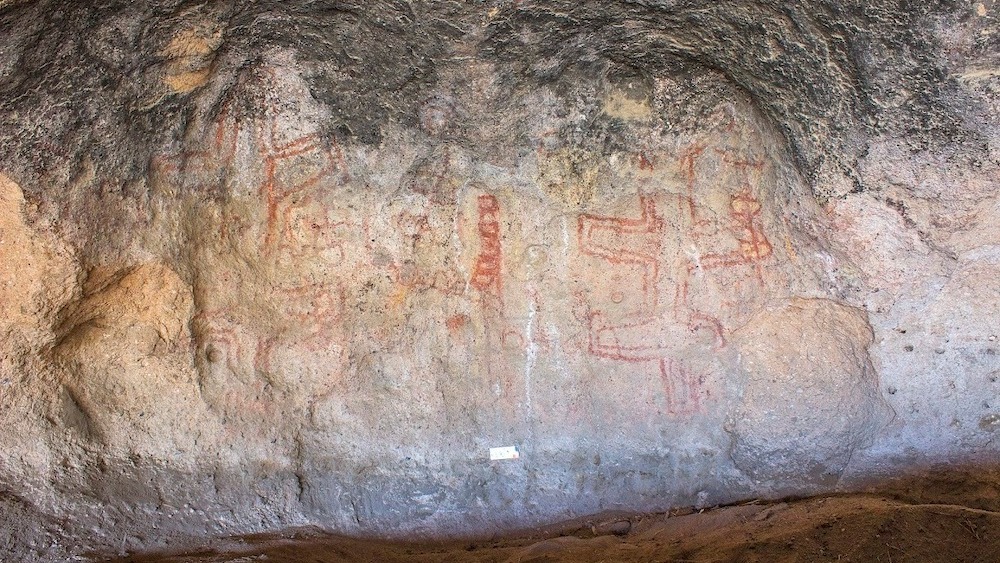Ancient rock art in Argentinian cave may have transmitted information across 100 generations
A cave in Patagonia houses the oldest known pigment-based rock art in South America.

A gallery's worth of rock art decorating the inside of a cave in Argentina is several millennia older than once thought and contains hundreds of drawings that span 100 generations.
At one time, archaeologists dated the art — located in Patagonia, a region in South America's southern tip — as being only several thousand years old. But a new analysis has revealed that some of the works actually date to as early as 8,200 years ago and were created during the late Holocene epoch (11,700 years ago to present), according to a study published Wednesday (Feb. 14) in the journal Science Advances.
"It turned out to be several millennia older than we expected," study lead author Guadalupe Romero Villanueva, an archaeologist with the Argentine National Research Council (CONICET) and the National Institute of Anthropology and Latin American Thought (INAPL), told Live Science. "We got surprised."
To determine the date of the massive artwork, which depicts humans, animals and other designs, archaeologists chipped away several small pieces of black pigment from the drawings. Since the pigment was made from plant material, researchers used radiocarbon dating to determine the age of the cave art.
"It's usually really hard to date rock art unless it has an organic component, otherwise there really isn't any material that you can date," study co-author Ramiro Barberena, an archeologist at Temuco Catholic University in Chile and CONICET, told Live Science. "[The cave] is not the oldest occupation in South America, but it is the oldest directly radiocarbon-dated pigment-based rock art in South America."
Related: Did art exist before early humans? New discoveries raise big questions.
Throughout the entire cave site, archaeologists counted 895 unique paintings grouped into 446 motifs, or segments. While research remains inconclusive as to which cultures created the dramatic imagery, researchers think that the elaborate work may have been used to pass along information between the illustrators and other communities, as well as future generations.
Get the world’s most fascinating discoveries delivered straight to your inbox.
"These [drawings] span more or less across 3,000 years within a single motif," Barberena said. "We propose that there was a transmission of information across multiple human generations, which inhabited the same region and the same site."
While it's unclear if the cave art was created as part of a "ceremony or an intergroup meeting, we think it was part of a human strategy to build social networks across dispersed groups, which contributed to making these societies more resilient against a very challenging ecology," Barberena added.
During the late Holocene, this region of Patagonia was known for being very dry and hot, according to the study.
"There were large parts of the landscape without water, but in order to survive as hunter-gatherers, they would have needed to stay connected," Barberena said. "It would've been hard to make it on your own, so an exchanging of information was important."
While there are other rock art sites in the region, the researchers said that the cave has the highest concentration, by far.
"It's amazing the amount of rock art we found there," Romero Villanueva said. "In the surrounding landscape there are several rock art sites, but none of them have the amount of the diversity in shapes and colors found here. So, it's evident that this place was likely a hot spot for communication in the past and crucial for the survivability of these societies."
Even though this is the oldest pigment-based cave art found on the continent, it's not the oldest in the world. That record belongs to a 45,500-year-old drawing of a warty pig scrawled onto a cave wall in Indonesia.
Jennifer Nalewicki is former Live Science staff writer and Salt Lake City-based journalist whose work has been featured in The New York Times, Smithsonian Magazine, Scientific American, Popular Mechanics and more. She covers several science topics from planet Earth to paleontology and archaeology to health and culture. Prior to freelancing, Jennifer held an Editor role at Time Inc. Jennifer has a bachelor's degree in Journalism from The University of Texas at Austin.


